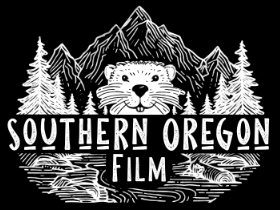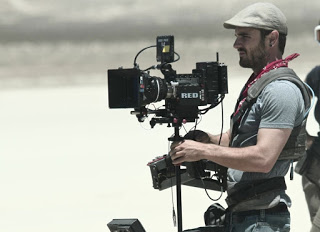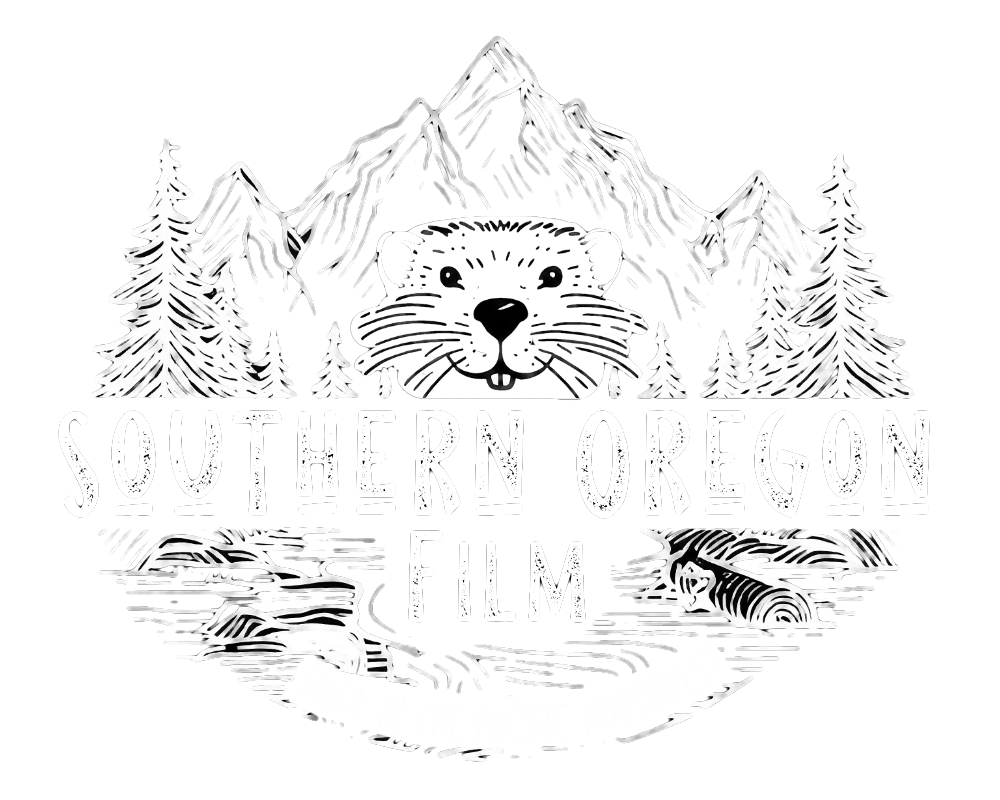With “Mad Max: Fury Road” currently blowing audiences hair back nationwide, I wanted to revisit another post-apocalyptic action film, very much inspired by George Millers previous Mad Max films, “Bounty Killer” (2013). You can read two previous reviews of the film itself here and here, but for this issue I sat down with cinematographer David Conley to talk about his contribution to the film as well as upcoming projects of his own.
LA: Bounty Killer is packed with action – from the fight sequences to car & motorcycle chases. What were some of the camera toys & tools that made it possible to get the coverage you and Henry Saine needed?
DC: Bounty Killer is definitely packed with a ton of action and shooting the movie was no different. Henry and I decided the movie needed a very active camera. I operated a Steadicam Flyer on nearly every scene in the film. On top of that we used a Jimmy Jib, which can go around 40 feet high, but my favorite toy we had was the Ultimate Arm. It is a black Mercedes SUV with a crane arm on the top. The car takes three operators: The driver, the crane arm operator, and the camera operator who calls all of the shots. In the right hands It is capable of capturing some of the most dynamic shots you can think of. Luckily for me, George Peters, who is one of the founders and an incredibly experienced operator with a long list of major credits, came out to operate the camera for me. It was a great pleasure directing him and watching him work. If you haven’t seen Bounty Killer, you most likely saw some of the Ultimate Arm’s handiwork on “Skyfall,” which was the movie they worked on just before.
LA: How much experience shooting this style did you have to draw from and how much of it was experimental or new to you?
DC: Before shooting the feature of Bounty Killer, we did the short film version, which acted as kind of a rehearsal for the feature. The short film pretty much consisted of the airstream trailer chase as well as the gas station fight between Marry Death and the guys from Second Sun. We were able to look at the short to see what worked and what we wanted to do better for those scenes. Often times we shot the same angles for the feature, but improved on them. Actually the entire knife fight scene where Jack fights a Gypsy inside the trailer was not reshot. Was pulled it straight out of the short film and dropped into the feature. That said, I don’t know if anything can really prepare you for shooting a movie like this. There is so much going on all at once in an action movie that it can be difficult to wrap your head around it. Sometimes we were shooting several scenes at the same time!
LA: I read in an interview with Christian Pitre that at times there were multiple units set up to capture as much in a production day as possible. So were you responsible for setting how each unit was going to shoot their sequences, and what kind of a camera team did you have for support? Or what else can you tell us about that kind of a challenge?
DC: We mainly had 2 units shooting simultaneously in separate locations, but we were often together. Bill Palmer and Jeremy Hayward were my entire 2nd unit team and they were awesome. In a feature you want all of the footage to be cohesive and look like it comes from the same film, so as the Director of Photography it is my job to make sure that happens. I had extensive conversations with my 2nd unit to make sure we were on the same page visually, but often times we were shooting the same scene together with them acting as my B Camera, so we were able to compare and make sure we were shooting the same movie. This can be a huge challenge because I often times was not able to check their work, so I had to have a lot of trust on the day. Then you can have a huge sigh of relief when you see the dailies and know that you have the right team.
Other than my 2nd Unit team, I had a 1st and 2nd AC supporting me as well as 2 camera PAs. One of my camera PAs, Louis Weissman actually ended up as my DIT and he did a great job despite the enormous amount of footage we threw at him and the incredibly difficult working environment. Often times he would have an inch of sand covering on the desk next to his laptop due to the conditions in the desert.
LA: Any moments that were particularly difficult or dangerous for you or your camera team?
DC: There were lots of difficult moments as well as some pretty dangerous ones. For the chase and gypsy camp portions we were shooting on the “El Mirage” dry lake bed, which is a massive area covered in a thick, chalky white sand. It is so large that you can drive in any direction without speed regulations and not worry that you will hit the sides. It was July and it was incredibly hot. A few members of the crew got heat strokes. I must have lost ten pounds out there operating a Steadicam. It is gross, but I have never sweat so much in my life. Also there were massive sandstorms. If you watch the background of one of the scenes you will see a sand tornado behind Mary Death. That is not VFX and just after we cut, it ripped through our set and threw pop up tents and equipment everywhere. One day it was so bad that the fan blades on my personal RED Scarlet-X were eaten away by the sand causing the sensor to overheat and rendered the camera inoperable for the remainder of the movie. On top of all of that, we were often racing around with the camera team hanging on in the bed of a truck to film most of the chase. I also shot some stuff from the roof of the airstream with a wire harness around me. It was exhausting, but a ton of fun.
LA: Any shots you had no idea how to pull off but got anyways?
DC: I would say that was the case for a lot of it. No one really knew this while we were shooting, certainly not the producers, but I had never operated a Steadicam before the film. I bought my Steadicam Flyer LE about 2 weeks before we went to picture and I spend preproduction following my Fiancé around our small apartment and teaching myself how to balance the rig. My first time using it outside was on the gas station fight scene, which was our first day of shooting. There was so much pressure with everyone watching, coupled with the silence of the set. I was terrified. Since I had never operated outside, the slightest breeze was able to knock me around. I had to learn fast and by the third day I had to operate some difficult stuff with Gary Busey, who would not do a second take for camera. It was good that I had that sort of experience because once we got to the sand storms of the desert I was operating in massive wind gusts, which you can definitely feel on camera.
LA: Was there anything in particular about this film that made you opt for particular equipment? Digital over film? Special lenses? Media management/DIT in the desert? Lighting considerations?
DC: There were lots of special circumstances that were considered and we were heavily bound by our budget. Unfortunately film was never on the table due to budget restrictions on how much footage we planned to burn. The media management in the desert was a nightmare. Everything was covered in sand.. all the time. Louis could hardly see the screen he was working on. It was very uncomfortable, but luckily it really didn’t have a major impact on the show. We had no computer crashes or hard drive crashes due to sand.
LA: You also have a lot of editing experience. As a cinematographer, how helpful or important is it to have that kind of knowledge going into a shoot?
DC: Yeah, I needed a way to pay my rent when I moved to Los Angeles because I believe longevity is a major key to success. I chose editing because it is hard for me to be on set without having a creative hand in it. Editing I think is very important in Cinematography and often overlooked. It is important to always remember that every image you shoot is part of the whole story and to understand where each image fits into that story. The director is constantly looking to me to reaffirm what she knows or to offer insight into how a scene will cut together. I find it much easier to shoot when I can say with confidence that one shot will cut with the previous and the next. If your shots don’t cut together well, your story cannot be told in way you and the director are envisioning and if that is the case, all of your hard work is pointless.
LA: You have recently done some directing, as well. The short film “Rolling Romance” and the upcoming “Who’s Driving Doug.” Is that something you’re looking to do more of? When you direct, do you shoot as well or collaborate with another cameraman?
DC: I did just finish a feature called “Who’s Driving Doug,” which was my first feature. For that feature I worked with a wonderful Cinematographer named Tom Clancey (no, not the author). He brought a great sense of story to the film as well as some really incredible skills and experience. I can’t wait for people to see it, I think his work really shines. I am definitely looking to do more directing and I was recently accepted into the Director’s Guild of America. I am currently looking for my next directing project.
LA: The lead characters of “Rolling Romance” are 2 people with muscular dystrophy who meet and fall in love. “Who’s Driving Doug” stars RJ Mitte, who happens to have cerebral palsy, is a coming-of-age story. What drew you to these films as opposed to another action thrill-ride like Bounty Killer?
DC: I love stories that I can connect to with characters that are relatable. “Bounty Killer” was a ton of fun and I would shoot another movie like that in a heart beat, but for my first directing projects I wanted something that was smaller in scale with less stunts so that I could focus on telling the best story possible. I came across “Rolling Romance” through a friend of mine who knew I wanted to direct. He introduced me to a very talented writer named Michael Carnick, who was looking for a director for his short film. Michael and I got along very well and I loved his script. We made “Rolling Romance,” which has been very successful on the festival circuit and that led to “Who’s Driving Doug.” I didn’t necessarily seek them out, but I am glad they found me because they were wonderful projects and perfect for me to start with.
LA: How did you get started in this business?
DC: I started taking classes in College at Southern Oregon University. I think it was Dr. Mark Chilcoat who really inspired me there with his very passionate lectures about film appreciation. He actually gifted me a super 8mm camera that I still have today. After graduating from SOU, I went to film school at Vancouver Film School in Vancouver, BC, Canada where I mainly studied Directing and Cinematography. Once I started that program I was hooked. After graduating in 2005 I was the first AD on a feature, then I shot a feature that made it to some festivals. I then went back to my old job in Geophysics, while I tried desperately to figure out how to move forward in film. I finally moved to Los Angeles in 2007 during the writer’s strike. I worked for free and I went broke. I took terrible jobs to pay the bills then I worked for free again until I went broke. I lived several hours outside the city and commuted in everyday. I would go for days and days on only a couple of hours of sleep. I often slept in my car on side streets in Los Angeles because I was too exhausted to drive home. Over time the free jobs become less and the paid jobs pick up. It is a process. They tell you it is a tough rough, but until you really attempt it, there is really no way of actually understanding. The key is relationships. The most important skill before anything else is knowing how to interact with people.
LA: Before you shot Bounty Killer, the film, you shot a short film version of that story. How did you get involved with director Henry Saine, and what’s it like working with him?
DC: I met Henry on another short film called “The Lake,” which was directed by Jason Dodson, who was the writer of Bounty Killer. Henry played the lake monster in that film and Colin Ebeling produced it. I got along so well with everyone that Henry asked me to do pickups on his last feature “The Last Lovecraft.” After that we were inseparable. Working with Henry is amazing and insane all at the same time. He the nicest guy and is truly a genius. He envisions every frame of the film in his head. Which can be good and bad because it is tough to surprise him. He is such a character and a great friend.
LA: How about working with Christian Pitre? I know you’re married now, but you were still single when you were shooting, right? 😉
DC: Ha! I was not married when we shot the film, but I was dating my wife who was on set for a lot of the film. Christian is amazing and a consummate professional. She is willing to go anywhere her character needs to go from throwing herself onto the desert floor next to a burning car to hanging off the side of a building, she is very dedicated. She also happens to be quite the looker, which is really great for the character 🙂
LA: Bounty Killer had some great actors in featured roles. Gary Busey, Kristanna Loken, Beverly D’Angelou, Abraham Benrubi… Who was a diva and who was a consummate professional?
DC: Working with everyone was quite an experience. Abraham is such a great guy. I would love to work with that guy any day. I would say the same for Beverly D’Angelou. I have been watching her since I was a kid with the National Lampoon films (I did have a crush on her back in the day), so it was such a pleasure to work with her. Gary is… Interesting and always a colorful guy with some very colorful language. He ran into my Steadicam on purpose during a take just to mess with me.
LA: Do you have a favorite genre, style, or story that you like to shoot?
DC: I love shooting everything as long as the story is interesting. At the end of the day the story is the only thing that matters. We have a project coming up that is a coming of age adventure story that I am very much looking forward to!
LA: Aside from “Who’s Driving Doug,” what other upcoming projects do you have in the works?
DC: I am currently shooting a feature called “Absolute Peril” (Working Title), which is scheduled for a theatrical release on October 23rd. It is a comedy horror film. I have a few other films coming that haven’t been pinned down, but I am definitely looking forward to them.
LA: Anything else you’d like to mention?
DC: We got our color done at Light Iron by colorist Paul Sage. He did some amazing work and really brought the film to life. The Moroccan looking town where we shot for “Bounty Killer” was the same set as “Iron Man” also they redressed it and used it again for “American Sniper,” which was pretty interesting to see.
LA: Many thanks for taking the time to share some of your insights and anecdotes. Best of luck in all your future projects!
David’s Official Website: http://cosmonautpictures.com
IMDB Page: http://www.imdb.com/name/nm2353521




